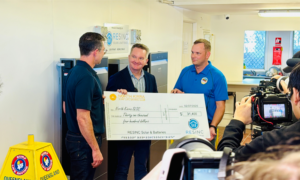The world’s second largest solar inverter manufacturer is partnering with Panasonic to develop, produce and market energy storage systems for residential and non-residential markets.
“We are thrilled to be aligned with such an innovative company and house-hold brand as Panasonic,” said Dr. Alex Levran, President, Renewable Energy Solutions at Power-One.
“Energy storage resources will greatly increase the adoption, use and sustainability of renewable energy systems throughout the world in homes, businesses, and in large utility plants.”
Mr. Tamio Yoshioka, Managing Officer, Director of Energy System Business Group at Panasonic Eco Solutions Company says the combination of his firm’s strengths in energy management technology and related products and Power-One’s expertise in power inverter technology will place the partnership in a good position to achieve the goals set for it.
Last year, Panasonic announced it will commence mass-producing a compact long-life lithium-ion battery system for home solar power applications.
The size of the global market for energy storage systems could exceed $11 billion by 2020. A report recently released by the Clean Energy Council states the market for energy storage technology in Australia will be equivalent to several coal-fired power stations by 2030.
Partly driving residential uptake will be continually increasing mains electricity costs. A battery based home energy storage system will allow for recharging during periods when electricity is cheaper; for use during peak periods.
Economical home energy storage systems will also be particularly attractive to some owners of solar power systems who export surplus electricity to the mains grid during peak periods, but receive pittance in return. That electricity can instead be stored for self consumption during low-light periods or at night; depriving electricity companies of the green and cheap peak period power they sell at a premium.
The rise of the home energy storage system may have some utilities rethinking how they treat solar households.












































